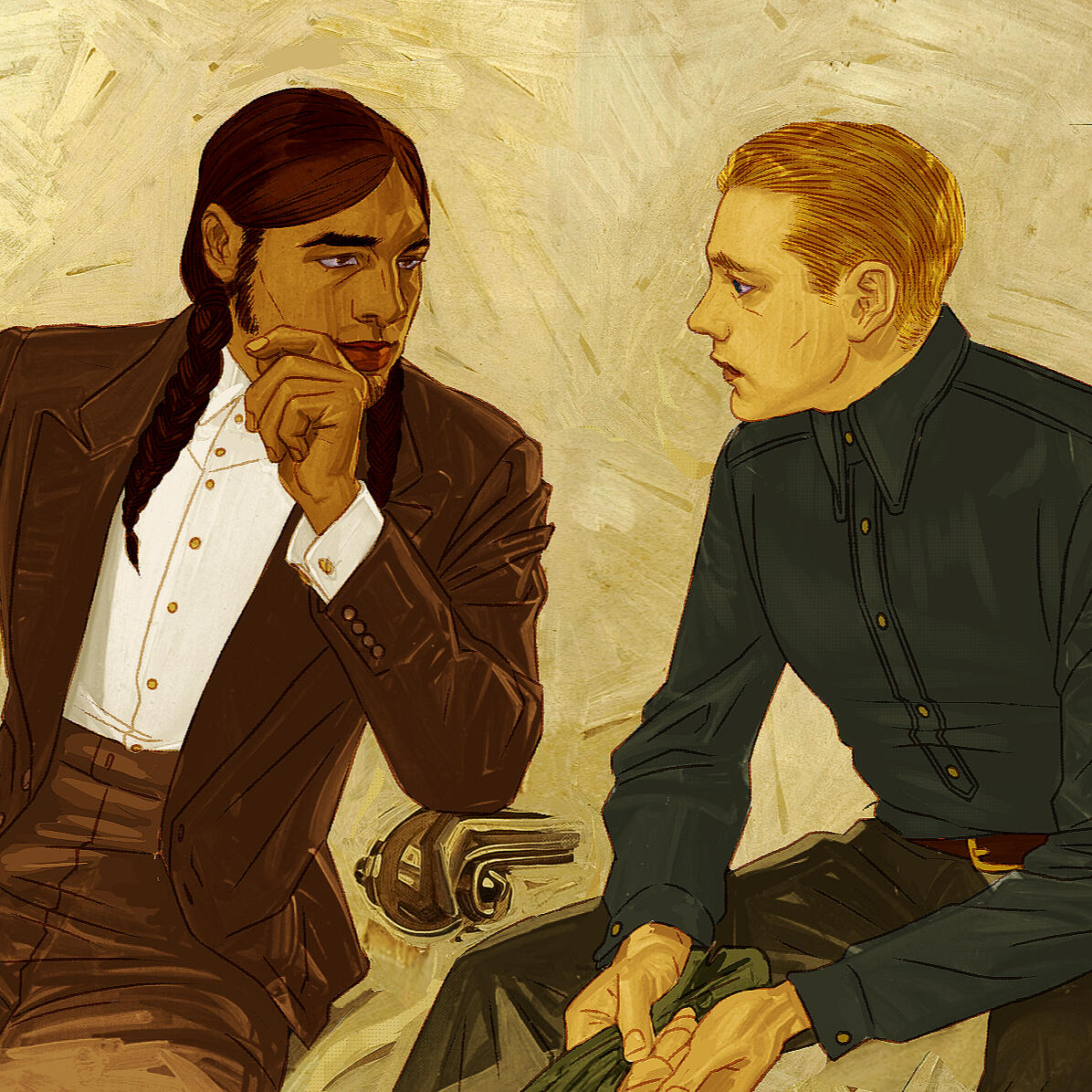
Letters from Dolaa
Worldbuilding Carrd.
Still a work in progress.
Characters

Venedictor Tarahank
Venedictor should have everything going for him - generational wealth and influence, a promising political career, even the blond hair and blue eyes favored by the Church. An injury sustained during his military service and a lifelong propensity towards homosexuality may, still, end up ruining everything.
Adrian Corta
Very popular in Vaneta's underground homosexual bars, which he visits whenever he's on the planet. An outlaw, a smuggler of all things banned by the Church and many more. Generally hedonistic, he still takes things more seriously than he may seem to at a glance.
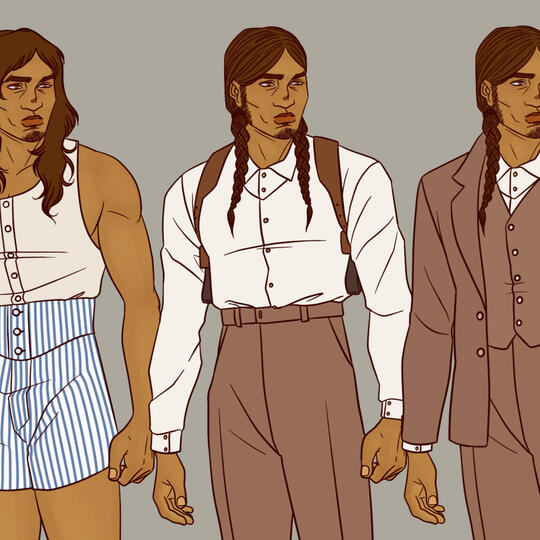
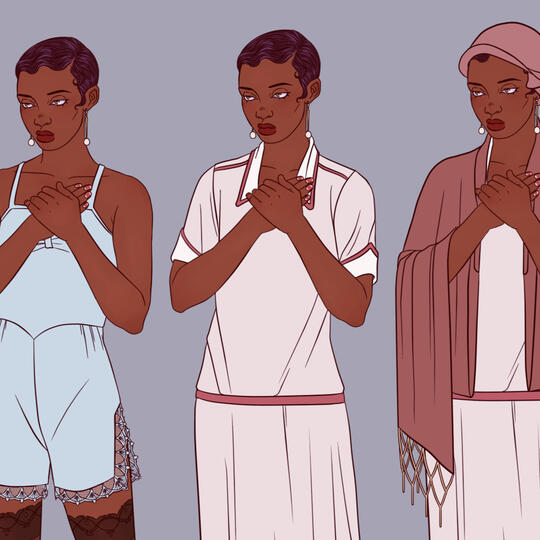
Melavir Benel
Venedictor's fiancée by arrangement and best friend by choice, since childhood. About as interested in men as Venedictor is in women - that is, not at all. She dutifully plays the role of the gentle, caring, motherly woman Vanetan culture expects her to be, biding her time until she can find her way off the planet.
Orator Bel
A decadent politician from one of those foreign, secular planets where sin and corruption run amok! Bel met Venedictor in an off-planet bar and, after a disastrous one-night-stand, they became rather close friends - despite the culture shock. Venedictor passes their friendship off as necessary political networking to avoid scrutiny.
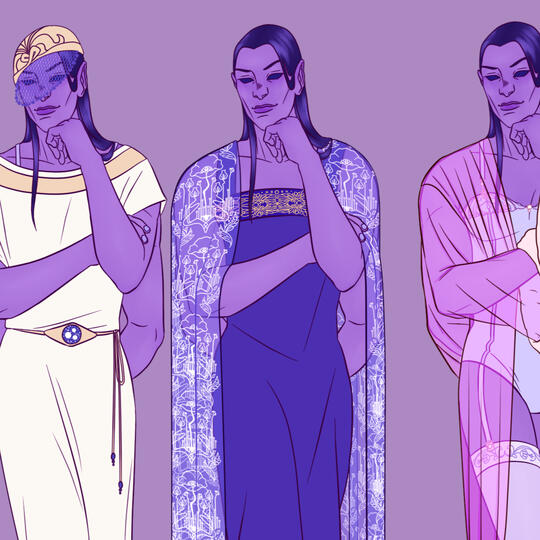
Solar systems

The Agedon system
Sicophus
Panerth
Vaneta (former Santinan colony)
Letinia (Santinan colony)
Santina (Human homeworld)
Arenie (Former Santinan colony)
Karfue
Mereto (Uninhabitable)

The Virin system
Hegonia (Uninhabitable)
Koyama
Dolaa
Moboes
Areeda
Allides

The Terzammar system
Maverne
Burletta
Auleev
Brieg (Has a human population)
Surlusle
Panerti

VANETA
A relatively small planet of the Agedon system.
Once a Santinan colony, independent for two centuries.
Population: 3 billion, almost exclusively human
Representatives: Orator NerusRadius: 3700 kilometers
Moons: Teba and Anker
Water prevalence: 63%: (46% Surface water / 17% Subterranean)
Climates: Range from arctic to tropical
Average temperature: 14°C
Length of day: 24 hours
Length of year: 366 days
Seasons: Mild differences between "cold season" and "warm season"

Areeda
A small planet of the Virin system.
Home to the Areedan people.
Population: 4 billion, mostly Areedan, with a minority of various foreign races
Representatives: Orator BelRadius: 3800 kilometers
Moon: Seela
Water prevalence: 82%: (62% Surface water / 20% Subterranean)
Climates: Range from arctic to Mediterranean
Average temperature: 10°C
Length of day: 34 hours
Length of year: 596 days
Seasons: Slight variations in temperature

Dolaa
A tiny planet of the Virin system.
Home to the Dolaa people.
Population: 600 million, almost exclusively Dolaa
Representatives:Radius: 1200 kilometers
Moon: N/A
Water prevalence: 92%: (70% Surface water / 22% Subterranean)
Climates: Tropical
Average temperature: 26°C
Length of day: 21 hours
Length of year: 267 days
Seasons: No seasons - circular orbit

Santina
The largest planet of the Agedon system, and the home planet of humanity.
Population: 9 billion, mostly human
Representatives:Radius: 6800 kilometers
Moon: Sarvil
Water prevalence: 67%: (41% Surface water / 26% Subterranean)
Climates: Cool to Mediterranean
Average temperature: 12°C
Length of day: 25 hours
Length of year: 655 days
Seasons: Mild changes in season
Vaneta's government
Vaneta’s government is a surface-level direct democracy. Due to political candidates all belonging to only two parties, both of which answer directly to the Vanetan Church, there is no real choice in government for the Vanetan people.Vaneta has two political parties. The Progressive Party (PP) and Conservative Party (CP). Both parties ultimately work towards the same goals: control of the Vanetan population, expansion of Vanetan territory and political power, and the enforcement of the Vanetan Church’s rule.The Vanetan government is headed by the Presidential Triumvirate, made up of two presidents and a vice-president. The two presidents rule together for six-year mandates and are elected by the Vanetan people through majority vote. Each president belongs to one of the two parties. To be elected, a candidate needs to be part of the official list of candidates of their respective party. There is always one progressive president and one conservative president. The two presidents are referred to as the Presidential Duumvirate.The two candidate system is officially meant to keep both presidents in check and balance out reforms between the two parties. In effect, though, both parties are essentially one, with the two-candidate system mainly serving to give the appearance of political change, substantial debate, and diversity of opinions.The vice-president represents the interests of both presidents and therefore does not officially belong to one party, though they may have been part of one in the past. They are meant to be seen as impartial. The vice-president takes over presidency should one of the presidents become incapacitated. They also preside over the Presidential Council and are a Councillor themselves.The Presidential Council is made of 12 councillors, each of them representing one of Vaneta’s 12 provinces. The Council is the lawmaking branch of the Vanetan government, as well as counsel to the Duumvirate. The Vice-President is one of the 12 councillors.The 12 councillors also act as Ministers of Education, Law, Culture and Economy. Three councillors share each the title of Minister for each Ministry; the Vice-president is always a Minister of Law, though they may have previously held a different Ministry.The Presidential Council writes, debates, and passes bills, using a majority vote system. Each bill is written and presented by the three ministers of the Ministry under which the bill falls. The bill is then debated by the entire Council. These debates are broadcast on Vaneta’s networks. While the debate is presented as a real-time event, the outcome of each debate has been predetermined by the Council, the Duumvirate, and representatives of the Church when necessary. The debate serves mostly as an explanation of the bill to the Vanetan public, and as an argument either for why it will be adopted, or why it isn’t necessary or is harmful - the predetermined losing side will always present lackluster or debunkeable arguments, which the predetermined winning side will thoroughly refute. These debates will usually be further summarized in the Vanetan press, giving the public an impression of transparency and clarity.
Ministry of Education
The ministry of education is responsible for public schools and higher education; public daycares; public activity programs for children and teens; education programs for children of immigrants; children's protective services; the foster system; laws regarding child welfare and the rights of children.
The ministry of education composes school programs and must approve all media aimed at children and teens.
The ministry has links with the Church, for religious education programs, and the army, for youth officer training programs.
Ministry of Law
The ministry of law is responsible for the judicial system; law enforcement; the prison system; interplanetary law and immigration.
The ministry of law has close links with the Church, due to the Church's role in defining religious crime. While the Church's leaders determine what is lawful or unlawful under God's will, the ministry of law is tasked with translating these guidelines into laws and determining sanctions.
The ministry of law is close to all other ministries and oversees the lawfulness of other ministries' dealings.
Ministry of Culture
The ministry of culture is responsible for diplomatic interplanetary exchanges; propagandizing; information to Vanetan citizens about the government and its dealings; information to foreign planets about Vaneta and its culture; public culture programs, museums, libraries; media morality control.
The ministry of culture has close ties with the Church, for religious information programs and religious propagandizing to other human and reproducible populations.
The ministry works in close proximity with the ministry of education.
Ministry of Economy
The ministry of economy is responsible for taxes; government budgeting; interplanetary trade; financial aid programs and grants; the regulation of on-planet markets; the regulation of wages and worker's rights.
The ministry of economy works closely with the ministry of law for the elaboration of financial laws.
The ministry of economy has some overlap with the ministry of culture regarding interplanetary exchanges.
History
Vaneta was once a colony of the planet Santina, humanity's homeworld. The settlers were almost exclusively Paragons, followers of the Church of God's Eye. These settlers would create an insular, extremely religious culture, which quickly drove away what few non-Paragons had invested Vaneta. Over the course of a century, Vanetan Paragons created their own structures of government and laws, eschewing Santinan culture, and created a separate denomination of the Church of God's Eye (referred to as the Vanetan Church or simply the Church), which recognized Vanetan leaders, was much stricter in its laws, and focused heavily on expansion of territory and growth of population.
Culture
The Church
The highest moral and legal authority on Vaneta. All Vanetan citizens are considered to be members of the Church, and therefore must live by its rules by law.The Church worships a single god (usually referred to as God, or sometimes as “the Eye”). The members of the Church are said to be God’s chosen, and are referred to as Paragons.The faith considers humans to be the highest form of life and the closest to God, with a secondary consideration for “reproducibles”, or alien species which may produce offspring with humans. Non-reproducibles are considered inherently lesser and incapable of holiness or true moral good. Humans and reproducible aliens who are not part of the Church are considered sinful.The Church highly values expansion and conquests, but does not seek to convert other peoples (aside from other humans). Due to this, contact with non-human species is not prioritized and members of the Church are typically sheltered from the rest of the systems.Vaneta has been a colony of the Church for only 200 years. Church members originally came from the much larger human planet of Santina. Vaneta is a relatively young planet, and it is relatively poor outside of the capital island. In order to become richer, stronger, and be able to pursue further conquest, the Church very strongly emphasizes reproduction – it is considered a woman’s duty to have as many children as possible, and there is very strong social stigma against those who cannot or will not procreate. It is illegal and very heavily stigmatized to enter relationships with non-reproducible aliens or people of the same sex.The Church is a higher authority than the government. The government is meant to act out the will of God – the Church dictates it. Guidelines of the Church are in large part outlined in a number of holy texts, but are also regularly clarified and added to by the Greatmaster, the Church’s leader, by methods of divination. The Greatmaster could be considered a politician due to this role, as they ultimately will determine what will become legal or illegal on Vaneta – the Council only serves to make these laws clear and specific.Upon turning sixteen, a Vanetan citizen is recognized as an adult, and this is the age at which they may choose to become part of the Church’s ranks. This is, however, no easy task: anyone looking to become a Church official must first and foremost clear a background check which verifies they have never been arrested for unholy behavior; they must have a record of having regularly attended Church services and religious events for at least the past four years; they must not have children under the age of sixteen; they must pass several tests on their knowledge of religious text and the history of the Church.Finally, those who have passed these requirements – about two thousand applicants each year – are gathered in the capital’s cathedral on the longest day of the year. There they will stand in several lines, and the current Greatmaster will walk between them. The Greatmaster, in a state of trance and led by an aide, will designate any number of applicants as unholy and have them removed from the cathedral. The remaining applicants will then be made members of the Church.As for those deemed unholy by the Greatmaster, of which there are several dozens each year, they are considered reprehensible and untrustworthy, and this could have severe repercussions on their social life or even their ability to hold a job or secure housing in the future. For this reason, many applicants go through the application process as quietly and discreetly as possible and avoid letting friends or family know that they are applying, so as not to reveal if they have been rejected.
The Capital Island
The Capital Island is the central hub of Vaneta’s culture. The island is in fact one single, massive city from coast to coast – it is in fact the largest city of the Agedon solar system. The island houses a large part of Vaneta’s population, and living on the island is often considered a goal for those growing up in other parts of Vaneta.The capital has the reputation of being the home of Vaneta’s finest and richest. This is only partially true. Some of Vaneta’s upper crust chooses, rather than the cramped, bustling island, to live in sprawling estates on the main continent. As well, life on the island is not simply a privilege reserved for the well-off. While the highest floors of the island’s vertiginous skyscrapers are luxurious and well-lit, the lowest levels, near the dirty streets and far from the sunlight, are the appanage of Vaneta’s working class, who toil night and day in various factories. Even below them, under the concrete streets, sit the capital’s dirtiest secrets: the speakeasies.Often referred to as “the bars” or “the parlors” by those who frequent them, they house whatever the Vanetan Church considers unholy and sinful: drugs and forbidden alcohols, the trade of birth control medication, the sale of pornography and censored media… Most outrageously, the parlors are the main place people go to to meet others interested in illegal relationships: relations between those of the same sex, or with non-reproducible aliens.The speakeasies are something of an open secret. They are thought of as being a myth by most outside of the capital, and even in the capital, some believe them to be few and far between. However, anyone living close enough to the ground knows them to be plentiful; the speakeasies have grown in the spaces left by a centuries-outdated catacomb system, and whenever law enforcement raids one, three more pop up somewhere else.
THE CONTINENT
Vaneta’s main continent houses the majority of the planet’s population. Most of the people, however, are concentrated in a few dozen large cities. Out from the cities radiate railroads, along which are built lines of buildings where the lower classes who cannot afford to live directly in the city reside.Vanetan agriculture is in most part automated, and is conducted in massive greenhouses within Vanetan cities themselves or at their outskirts – therefore, Vanetan cities are mostly self-sufficient. A few roads and railways link the various cities together; aside from these, however, there are almost no roads or trails of any kind across the vast majority of Vaneta’s surface, and the natural flora and fauna rests untouched (and, in large part, undiscovered) outside of the cities.Due to the concentration of people, agriculture and business almost exclusively in cities, the country is only inhabited by the wealthiest of Vaneta’s people, who can afford to live away from the cities with the convenience of frequent deliveries of food and goods, and the costly installation of running water and electricity to their remote homes.Country estates are an inspirational goal on Vaneta. Huge, sprawling properties, they sit away from the pollution and any near neighbors, in the middle of Vaneta’s natural beauty. They are often inaccessible by anything but hover cars, due to the lack of roads on most of Vaneta’s surface.
Vanetan Geography
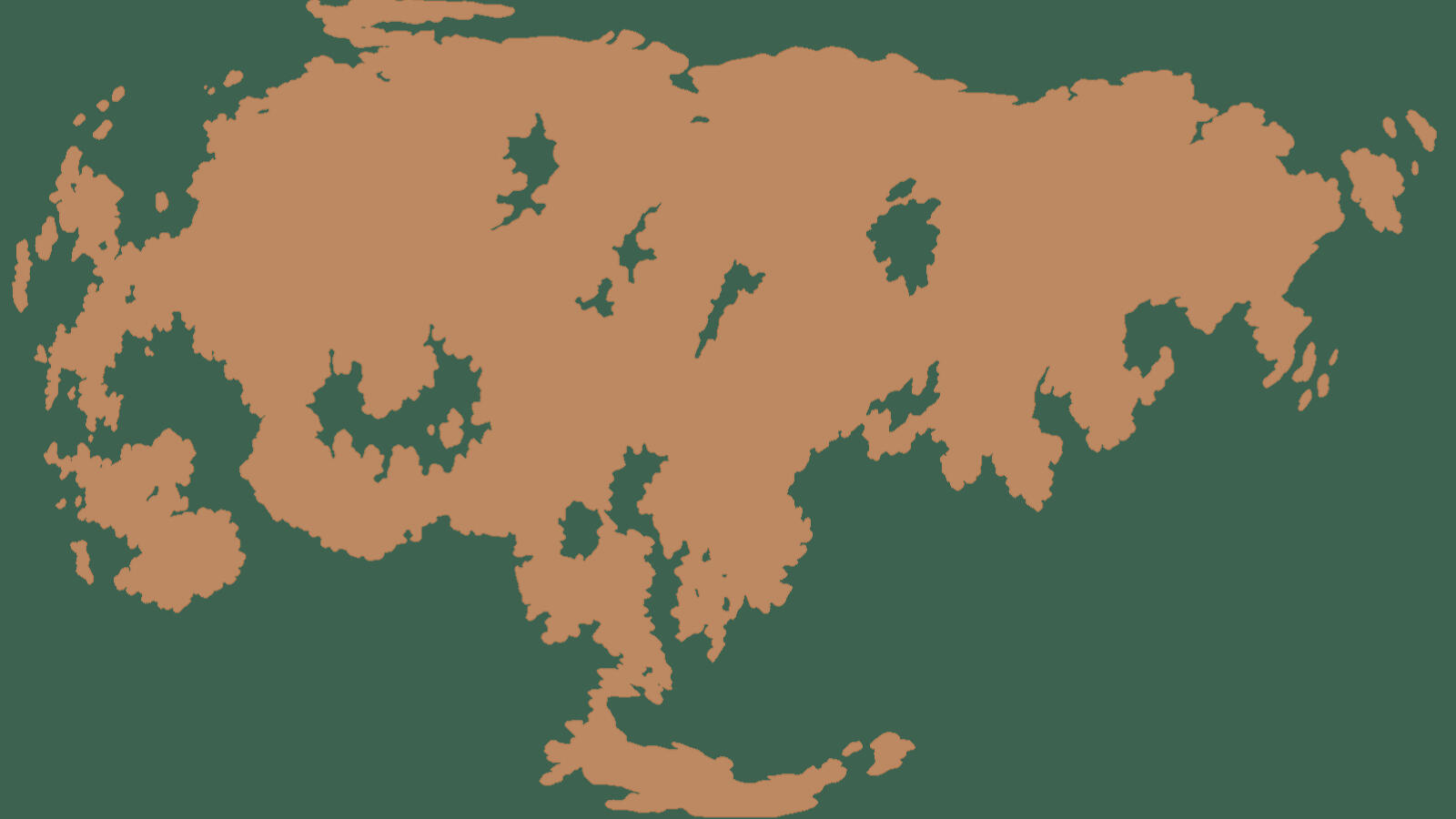
Map of Vaneta
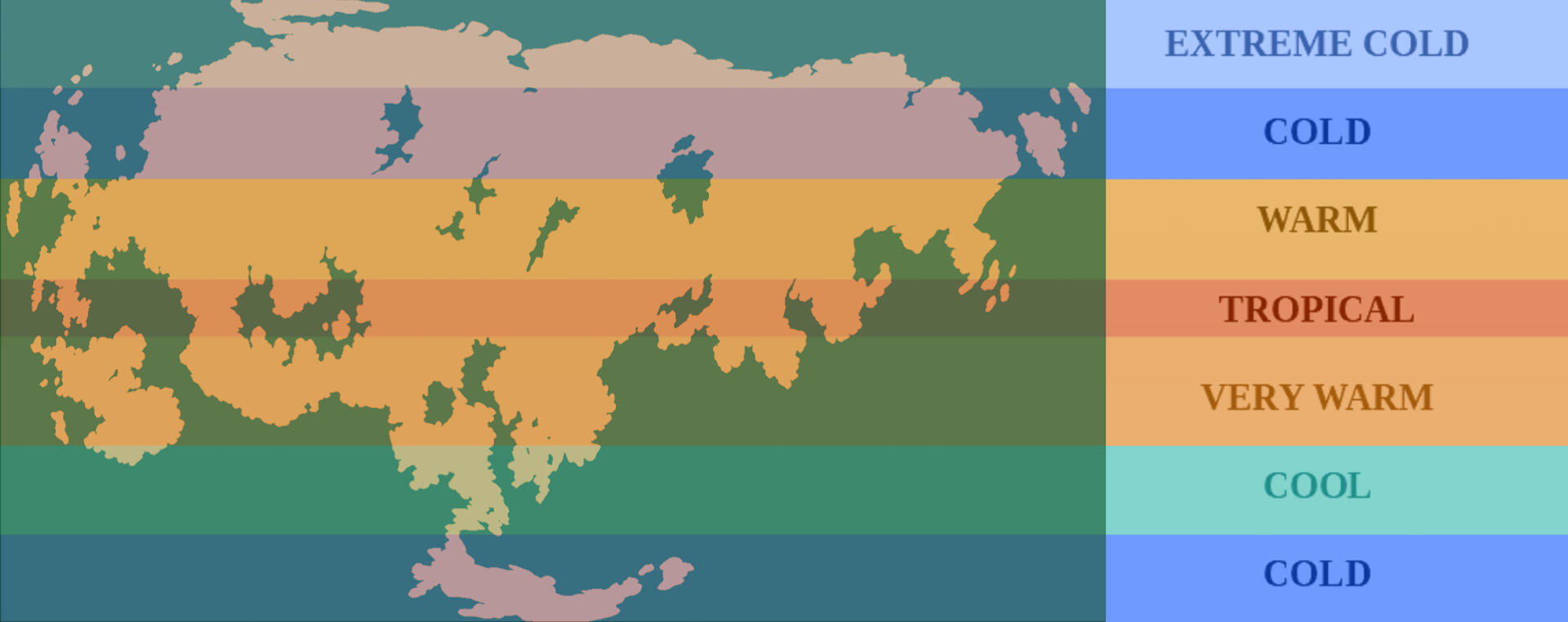
Vanetan climates
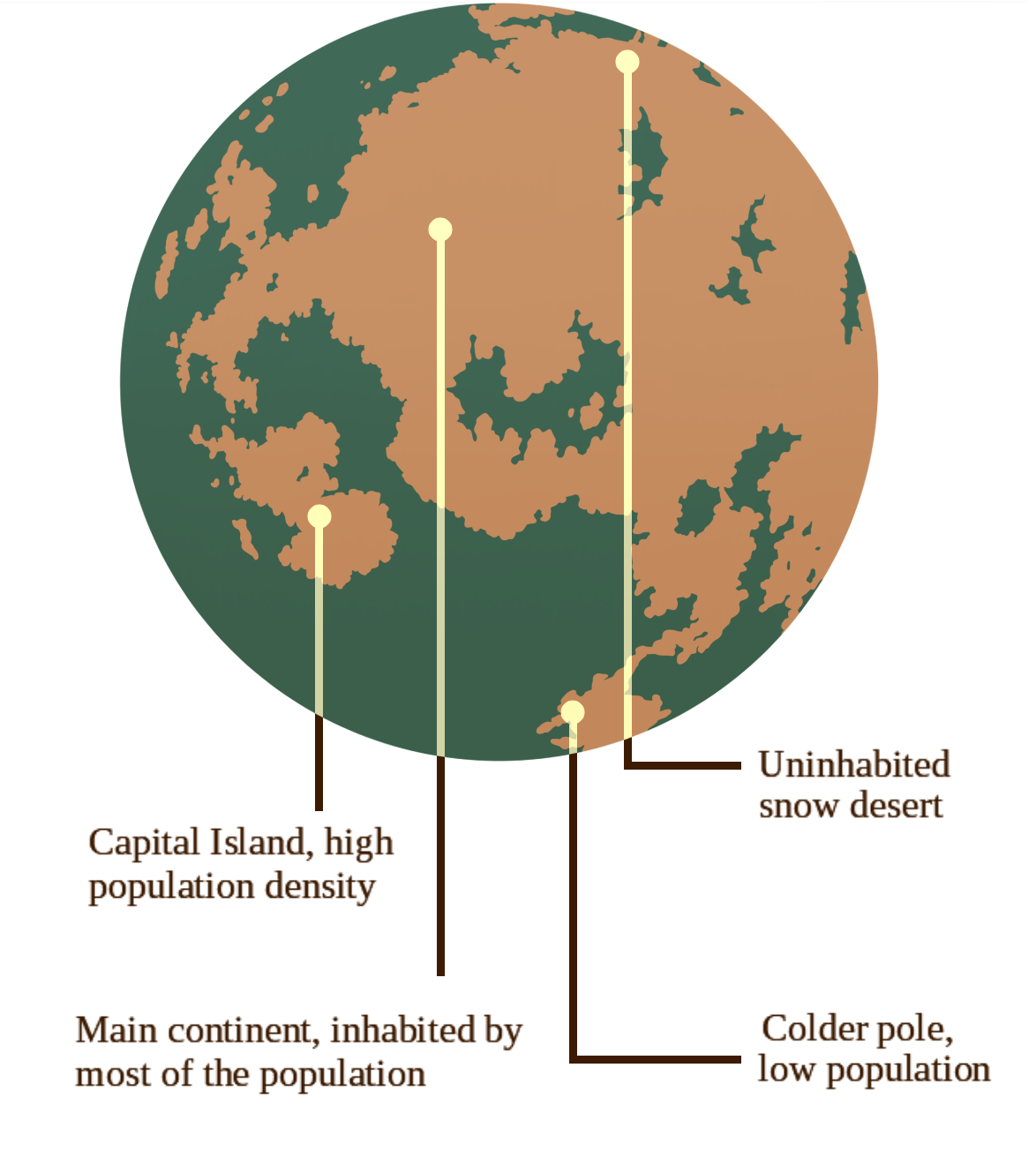
Population distribution
Presidential Triumvirate

President Tanson
Vaneta's current Conservative Party president. A heavily-decorated former military man. Previously Minister of Law. Close with Councillor Tarahank.

President Belon
Vaneta's current Progressive Party president. A former Orator with close ties to the Church. One of Vaneta's youngest presidents to date.

Vice-President Damas
Grossly over-qualified. A former Orator, before Belon; former Minister of Education; current Minister of Law. Once a teacher in the army's youth programs, now a mother of four.
Presidential Council

Councillor Chenie
A newer, but popular young counselor. Very religiously inclined; close to Greatmaster Taramine. Minister of Education. Currently on her second pregnancy.

Councillor Tarahank
A former colonel. Conservative councillor for 20 years. From an influential political family. Minister of Law.

Counselor Beten
A conservative Council member for the past 27 years. Most popular with the older, conservative generation. A Minister of Economy. Close to Councillor Tarahank.
Key players

Orator Nerus
Vaneta's Orator for the Intersystem Assembly. Influential with the Presidential Council. Close to Vice-President Damas. Most popular with the progressive youth. Recently found to be dying of a terminal illness.

Greatmaster Taramine
The very young head of the Vanetan Church, appointed just two years ago. Quite popular with Vaneta's youth. Her background is still mostly unknown.

Pao Simbia
Heir to Simbia Co., Vaneta's largest arms manufacturer. He wanted to join the Church's ranks, but had to take over the business after his father's early passing. Easily upset, childish.
Areeda's government
The Areedan government is a constitutional, elective quintumvirate, ruled by five heads of state of equal power, called Sree. The five Sree are elected by the Areedan people through an approval voting system, where citizens vote for any number of candidates they approve of, and the five candidates most voted for are elected. The Sree are bound to a constitution, the Charter, which lays out base obligations and prohibitions. The violation of these constitutional rules is the only reason a Sree may be removed from power. Unless the Charter is violated, a Sree will remain in power until the event of their death. This system where the end of power is dictated by the end of existence or by the violation of a rule is most suited to Areedans, who do not have a notion of linear time.The Sree share absolute power, and determine the laws and legislation in place on Areeda; Areeda’s positions on interplanetary affairs; Areedan interplanetary commerce; the regulation of Areedan economy and markets; any other matters of state.The Areedan quintumvirate is counseled by a court of Wisepeople, who are hand-picked by the Sree. Anyone may become a Wiseperson – there are no requirements of age, class, or even citizenship, with representatives of other planets and races having sometimes become Wisepeople. The Wisepeople do not have official political power, and are only advisors. However, Wisepeople may have considerable influence over one or several of the Sree and therefore become unofficial rulers. Like Sree, Wisepeople may only be expelled from the court by the Sree who appointed them or if they are found to have violated either the Charter, or the Wisepeople’s Rule, a set of guidelines for appropriate behavior in the Areedan court. The Orator representing Areeda in the Inter System Assembly is one of the Wisepeople, elected to Orator by the five Sree.Both the Charter and the Wisepeople’s Rule may be modified by the Areedan public through either plurality vote (where only one change is proposed and the people must vote “for” or “against”) or an approval vote (where several potential changes are proposed and the people vote for any option they would approve of, with the most popular option being made law). These changes may be proposed by any member of the Areedan public, though in order to be voted upon, at least ten thousand people must declare themselves in favor of the change; only then will it be put up to a planet-wide vote. This is facilitated by the use of data networks, where Areedans will petition for people to recognize their proposal via online voting. A Sree cannot propose a change to the Charter or publicly declare their opinion on a proposed change; neither can a Wiseperson regarding changes to the Wisepeople’s Rule.
The Areedan Charter
A text which outlines the rights of the Areedan people and the obligations of the Areedan government.
MAREE1. Mke, ta areedaljee, ba ljee herima.2. Mke, ta herikumi reedama, ba Tesni.3. Mke sasa, ta swaree herima.4. Sreedima, ta mime, ba Sree naka.5. Rafima do moma, ta reedali, ba Sree kreea.6. Momali, ta Sree kreea, ba Sreemari.7. Tsakadi moma, ta Kismareeli mka kija, ba sree kreea.8. Namka ken, ta Sree kawa, ba Kismareeli.9. Momali, ta Kismareeli, ba Sreemari na Maree Kismareeli.10. Timadi moma, ta rafidi nanka do Sree, ba reedali.11. Timadi moma, ta seeda sreemarima daa wanee luhula daa Sreemari ka Maree Kismareeli, ba reedali.NANKA
1. Maba, ta reeda kreea, ba mabadila e nanka namkatama daka Sreemari, da lekiliaka e go o mbuji o mokela o seedee o mkela salu.2. Mke, ta reeda kreea, ba kiliala daka herimaree.3. Keseedi moma sasa, ta keenaree, ba rikika o saluposa o rikee.4. Maba, ta kreeli, ba nanka e hera wahima na kreemala.5. Maba, ta kreeli, ba nanka e mja wahima na kreemala.6. Maba, ta kreeli, ba nanka e bamala lekilama ka ishir o lekishi.7. Maba, ta kreeli, ba nanka e bosadila hereema na leshirkama.8. Maba, ta kreeli, ba nanka e suseela de bokola sreema, da i sakoma.9. Maba, ta kreeli, ba nanka e moki na nemkela, da dakado Areeda.10. Maba, ta kreeli, ba nanka e keemoki e Areeda.11. Ken moke na nemkedi lupoma, ta reeheli kreea e heri wahima, ba Areeda.12. Wanima, ta heree, da nade nanke kreea krijleema daka Sreemari, ba reeheli kreea e heri wahima.13. Wanima moma, ta wahidila e bokola, stini e nemkedi do Areeda na heree na nanke kreea krijleema daka Sreemari, ba reeheli kreea e heri sawasama satobma wahira do Areeda.Mke, ta nanka sakeesama.
THE RULE1. Areedan shall be our official language.2. The capital of Areeda shall be Tesni.3. There shall be no religion of state.4. We shall be ruled by five Sree.5. Each Sree must be voted upon by the people.6. Each Sree must abide the Charter.7. Each Sree must be advised by at least one Wiseperson.8. Wisepeople may only be appointed by a Sree.9. Wisepeople must abide the Charter and the Wisepeople’s Rule.10. The power to vote upon the Sree shall belong to the people of Areeda.11. The constituent power to propose changes to the Charter or Wisepeople’s Rule shall belong to the people of Areeda.THE RIGHTS
1. All Areedans are equally entitled to the rights defined in this Charter regardless of their age, gender, provenance, class, or other status.2. All Areedans are equal before the law.3. None shall be subject to torture, imprisonement, or cruelty.4. All have the right to safe and sufficient housing.5. All have the right to safe and sufficient food.6. All have the right to fair compensation for their work or services.7. All have the right to dignified and qualified healthcare.8. All have the right to a hearing with the governing authorities should they request it.9. All have the right to move and change residency throughout Areeda.10. All have the right to leave Areeda.11. Any representative of a non-hostile nation may enter Areeda and reside there freely.12. Any representative of a non-hostile nation residing on Areeda will be offered citizenship, and with it all the rights outlined in this Charter.13. Any representative of a hostile nation seeking refuge on Areeda will be given the protection of the authorities, permitted to reside on Areeda, and offered citizenship and all the rights outlined in this Charter.These rights are unalienable.
KISMAREELI MAREE1. Samomsa kebeendi o beenadi o danadi boko e kehela salu, da ken mke sarikama e Sree o heri, ta Kismareeli.2. Samomsa samalima, ta Kismareeli, ba Sree. Sasa ljeedi smala o sakunama, ta tahi, ba Sree. Sasa saljeed o saboko beenadi, ta tahi, ba Sree.3. Samomsa samalima, ta Kismareeli, ba Kismareeli salu e juma.4. Samomsa kjeedi reekma o samalima, da daka juma, ta Kismareeli.5. Samomsa ingeka o moki sereesma o smeeksadi, da daka juma, ta Kismareeli.6. Samomsa mke samalima o sereesma, da e ken ibobadi do juma o heri sasa, ta Kismareeli ljeebeenama kehela salu.7. Mke moma akishama kree daa taskadi e Sree, da i pakee, ta Kismareeli.8. Moma ljeebeena na kjeedi e mala e taska tahima, da daa bokoma lekma na bakee kufiree kree, ta Kismareeli, ba Kismareeli salu e juma.9. Moma keemoki juma kree, da daa mokeeni heri reedama nade heri salu, da sasa mke bakomsa e reeli saka juma, ta Kismareeli.
THE WISEPEOPLE’S RULE1. The Wiseperson must not carry business, trade, or share information with external entities which could be detrimental to the Sree or the nation.2. The Wiseperson must not disrespect the Sree. They must not speak rudely or mockingly to the Sree. They must not speak ill of or gossip about the Sree.3. The Wiseperson must not disrespect other Wisepeople of the court.4. The Wiseperson must not engage in angry or disrespectful debate in the court.5. The Wiseperson must not imbibe, behave inappropriately, or cause scenes in the court.6. When conversing with external entities, the Wiseperson must not be disrespectful or inappropriate in ways which would reflect badly upon the court or the nation.7. The Wiseperson must make themselves as available to counsel their Sree as is possible.8. The Wiseperson must converse and debate with other Wisepeople of the court on the subjects they serve as counsel on, so that they are well-informed and understand many points of view.9. The Wiseperson must regularly leave the court to visit the Areedan nation as well as foreign nations, so that they do not fall into ignorance of people outside the court.
Sree Jadee

A ruler of Areeda. He has a pointed interest in the arts and invention, subjects considered very important in Areeda's culture. His artistic passion leads him to be almost too reclusive for his function, though he has so far continued to fulfill it.
Sree Mkela

A ruler of Areeda. Ze is the Sree most involved in matters of law. Ze has a strong interest in philosophy and ethics and gives impassioned speeches on morality. Despite zir focus on the law, ze is known for being lenient and compassionate.
Sree Seeki

A ruler of Areeda. Of all five Sree, they are perhaps the most involved in matters of the economy. They have a deeply analytical mind, and a reserved, polite demeanor. They are well-known for their devotion to their work. Their favorite hobby is solving equations.
Sree Satobma

A ruler of Areeda. A well-traveled diplomat, with a profound interest in other cultures. She is known to have a taste for the lavish and the exotic, as well as many devoted friends from planets all over nearby systems.
Sree Krisma

A ruler of Areeda. Of all five Sree, she is perhaps the most versatile. She approaches law, culture, diplomacy, and the economy with the same no-nonsense, straight-to-the-point attitude, which has made her a proficient ruler.
Kismareeli Nankama

A Wiseperson appointed by Sree Krisma. He is quiet to the point of shyness, and so reluctant to debate it almost breaks the Wisepeople's Rule. Despite this, he is known to disappear with Krisma for days at a time, after which Krisma always seems enlightened and confident in her decisions.
Kismareeli Crent

A Wiseperson appointed by Sree Satobma. Crent is a Cratean, from the planet Karfue. Their secretiveness, often incomprehensible babbling, and immunity to telepathy seem to please the Sree, as they are held in high regard in the court.
Kismareeli Pakeeta

A Wiseperson appointed by Sree Seeki. They are law-abiding, respectable, and polite to a fault. Pakeeta is deeply interested in literature and poetry; they are known to be Sree Seeki's closest confident, as their spiritual outlook balances out Seeki's analytical one.
Kismareeli Matami

A Wiseperson appointed by Sree Jadee. Having travelled to dozens of planets and encountered hundreds of cultures, Matami embodies the ideal of the Wiseperson as a wealth of knowledge. He is very close to all five Sree.
THE COURT
Areeda’s court constitutes the city center of Tesni, the Areedan capital. The court is not simply where the Sree live; while the Sree’s quarters do make up a portion of the court, most of the court is a public, open space, where not only the Wisepeople, but the Areedan people congregate. The entirety of the Areedan court spans about 1000 acres, about a third of which constitutes the quarters of the Sree.The Sree’s quarters are not public, and permission must be requested for citizens to enter them. A Sree’s quarters not only house the Sree themself, but also the Wisepeople they have appointed; the quarters are similar to a gated community. As well as this housing, they will also include libraries, laboratories, and any other infrastructure the Sree has determined necessary. These quarters may be overhauled to some extent whenever a new Sree is elected so as to include the infrastructure they have requested, and throughout history their population has vastly varied – quarters may be almost deserted when their Sree has only appointed a handful of Wisepeople, or crowded when they have appointed dozens.Nevertheless, the Sree’s quarters remain a place of study, respite, and quiet. This is not the case of the public court.The public court is a popular meeting place, and perhaps the most popular touristic spot on Areeda. The court is made up of several grand boulevards, with a few libraries, cafés and other sparse establishments separating them. Many fountains and patches of grass and vegetation can be found throughout it. At the center of the court is a great plaza, where the Sree will regularly be found, meeting their citizens and talking with those who wish to speak to them – this is also where the Sree will give speeches. The Wisepeople are also most often found walking the court. Many of them will engage in political or philosophical conversations and debates – a behavior actually required of them by the Wisepeople’s Rules – which will most often be very open and may be interjected in or joined by the public.The court also serves as a marketplace, allowing artisans and farmers to sell their goods freely. It is also a haven for the arts: musicians will often give impromptu concerts, authors will read prose out loud, and theater troupes will give public representations in the street – these, especially, are beloved by the Areedan people, and regularly large-scale plays will take place throughout the court, inviting the public to walk from one scene to another or follow the characters around.
Harbor cities
Harbor cities make up all the largest Areedan cities - the biggest being of course Tesni, as well as the economic capital Hata, and large cities Kmama, Numbani and Anaree. Harbor cities revolve around their harbors. They are places of travel, and highly touristic; they are economically flourishing; they are known for constant events, marketplaces, conferences, festivals. The harbor cities, in many ways, are the cultural inspiration for the Areedan Court - their effervescence, their organization, their architecture have been amplified in the court.Many of Areeda's youth dream of one day living in a harbor city; this dream, however, is not always accessible due to the high cost of living.
Dolaa's governments
Dolaa was still recently populated by a number of disparate ethnic tribes, each divided into small self-governed groups. Over the past century, a number of these small nations occupying the Southern Archipelago – an area with a cooler climate and more arable land – have unified, forming the Lakaa Empire. These once nomadic tribes have settled into a sedentary lifestyle all over the Southern Archipelago. However, this sedentarization has exhausted the natural resources of the Southern Archipelago. The Lakaa Empire has therefore began to infringe upon territories further and further north to continue to sustain its growing population.The Lakaa Empire is a hereditary monarchy, where the title of Emperor is passed down to the oldest child. The Emperor is aided by several lieutenants, most of them descendants of previous tribal leaders, who sustain the Emperor’s authority throughout the Empire’s territory. These lieutenants enjoy great personal freedoms and power over the territories assigned to them, and act as smaller rulers in their own right.Territories to the north of the Lakaa Empire are still populated almost exclusively by small nomadic tribes, who are technologically less advanced than the Lakaa Empire, and do not have organized armed forces. These tribes use a number of systems of government, though most of them recognize either one leader or a small group of leaders. These leaders usually receive their title hereditarily, though some may be elected by their tribe.
Dolaa Geography
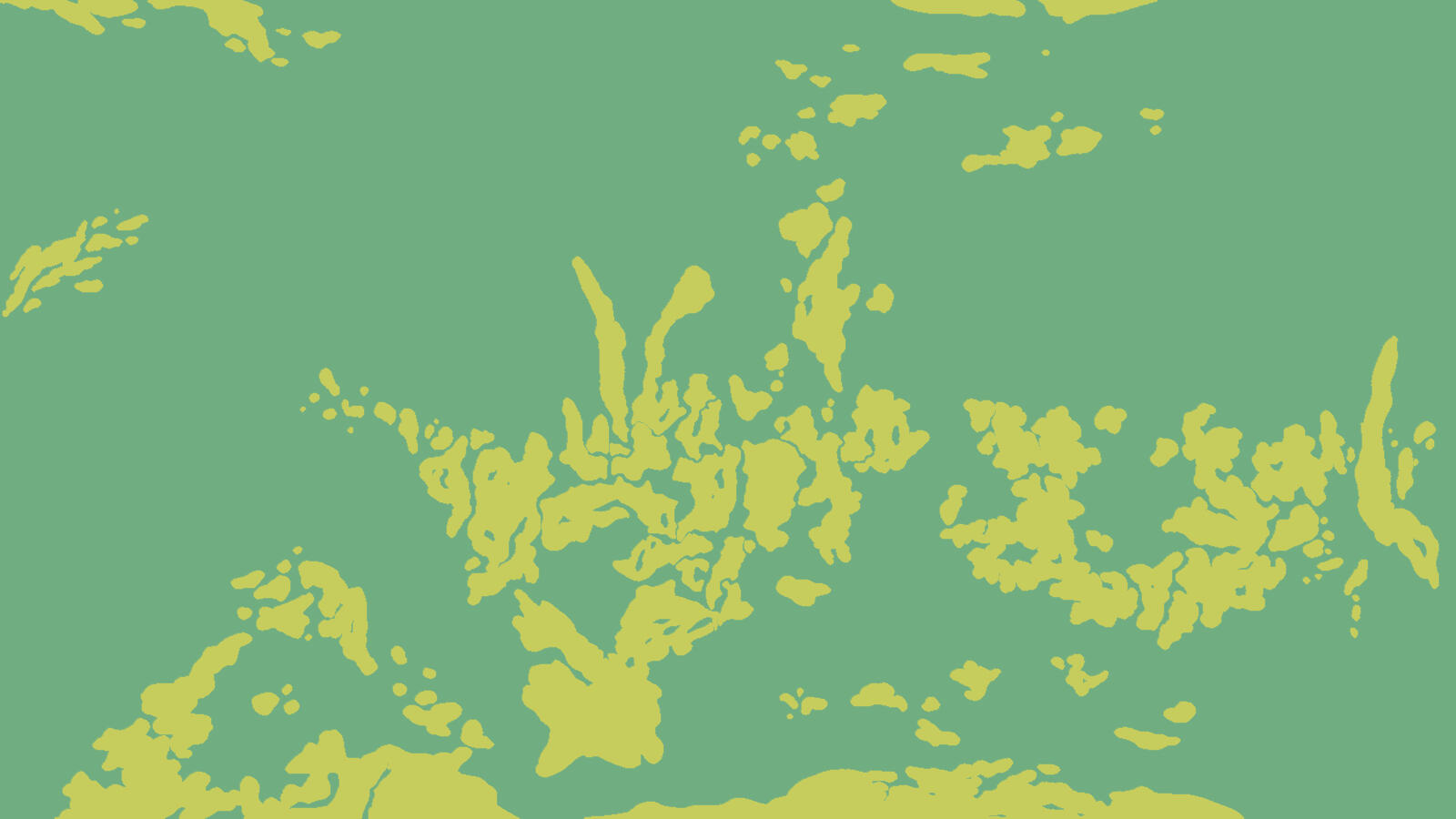
Map of Dolaa
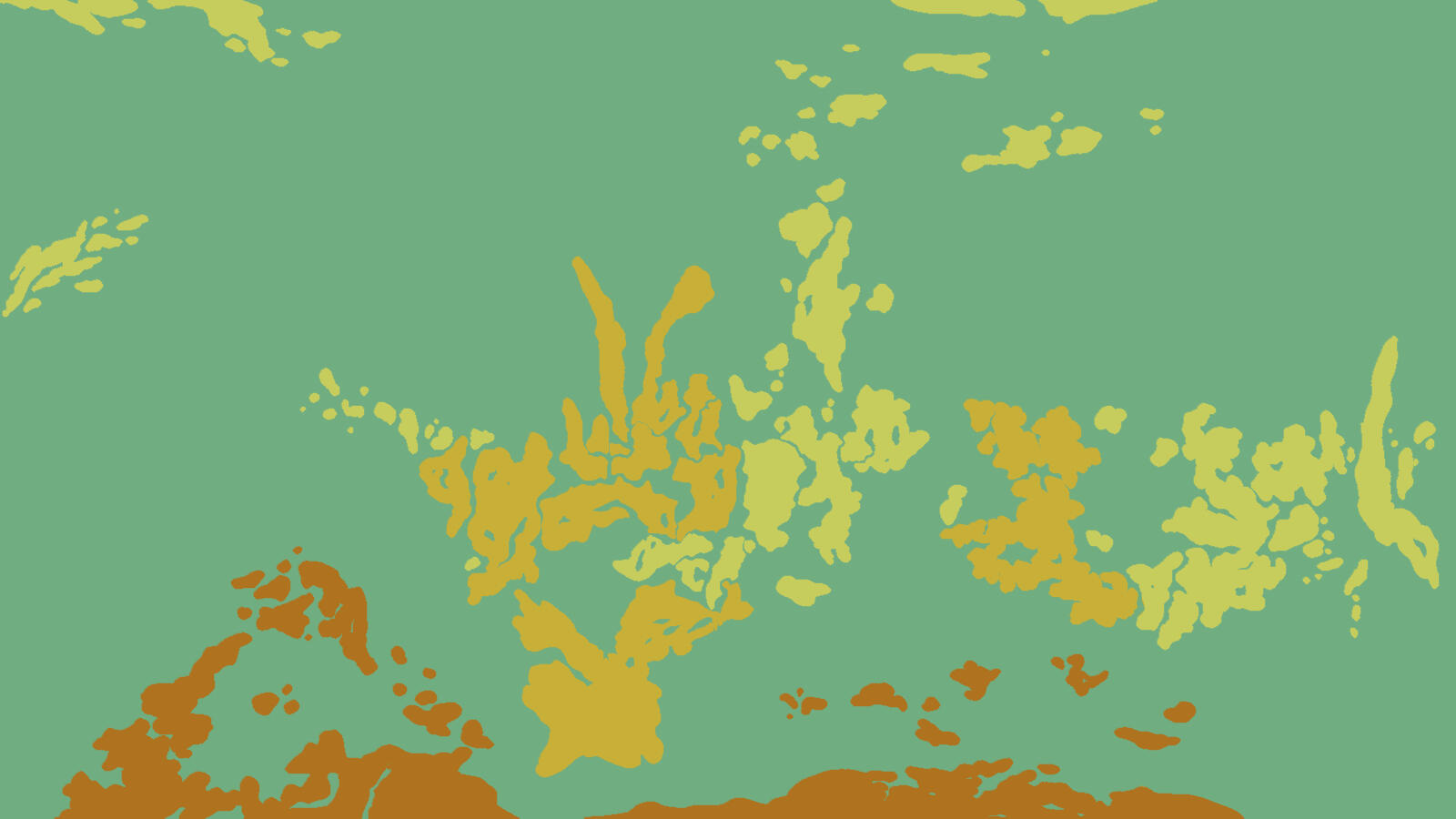
Political map
Regions controlled by the Lakaa Empire
Regions being invaded by the Lakaa Empire
Territories inhabitated by nomadic tribes
Suuva Alimba the Third
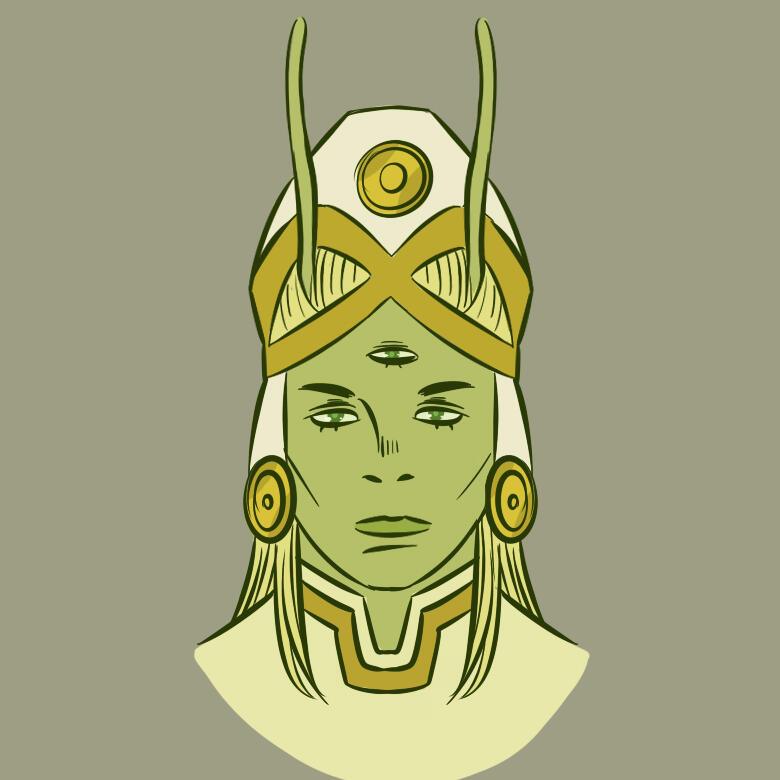
The current Lakaa Emperor. Known to be ruthless, power-hungry, and strategically minded. He has three children, all daughters, and is rumored to have killed an elder son at birth as he believes a girl is more suited to rule. This may or may not be true.
Melin Asanbe
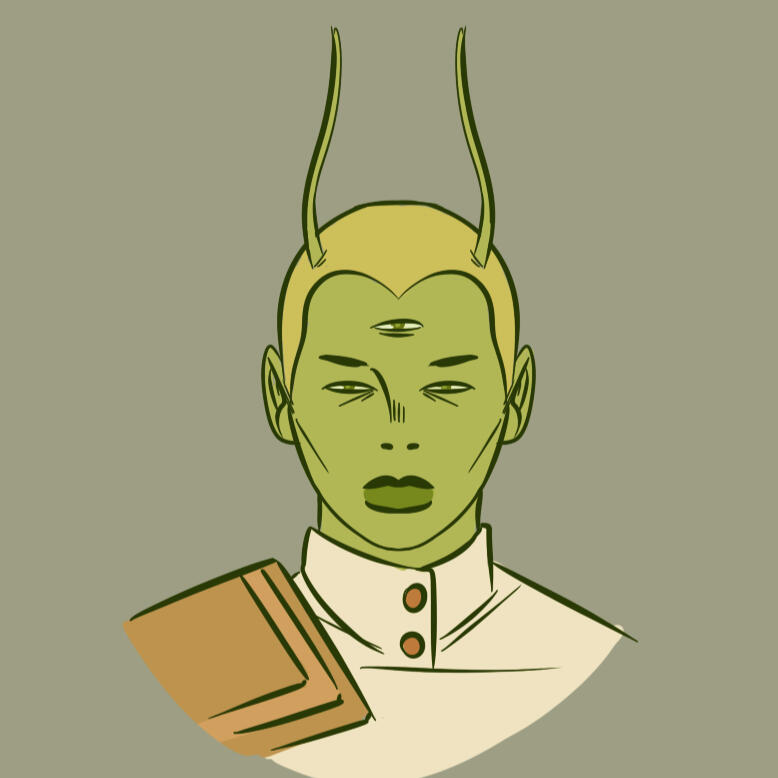
A Lakaa lieutenant, from the ruling line of the Asanbe tribe. She is trusted by her people and known to be diplomatic. She is generally benevolent to all Lakaan citizens, though she is known to favor those of her tribe.
Kukrish Lenenia
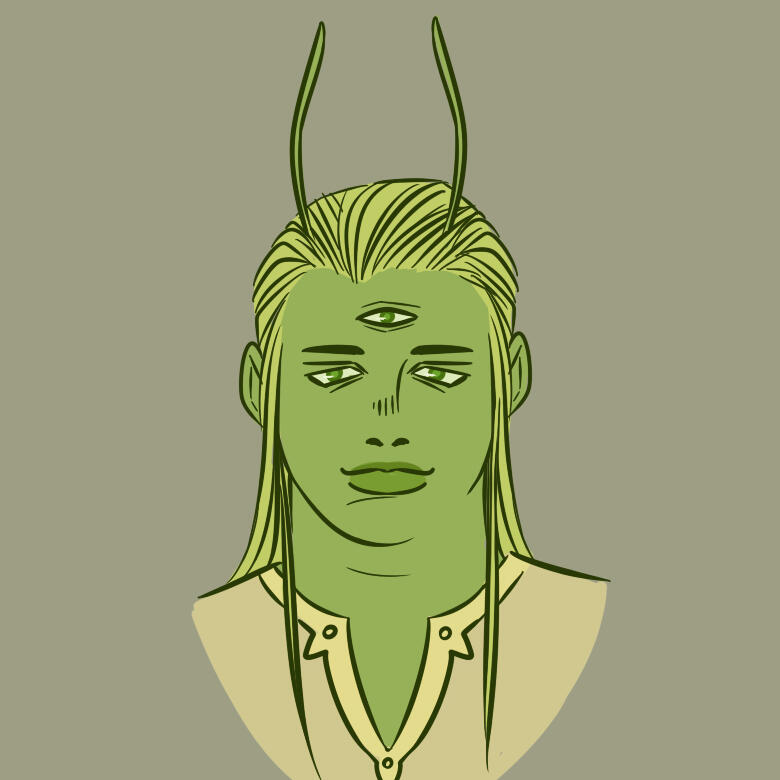
A Lakaan lieutenant, from the ruling line of the Kukrish tribe. He is young and mellow, more preocuppied with enjoying the spoils of power than with securing it, and is known to be under the control of his advisor, Arkrish Selane.
Arkrish Selane
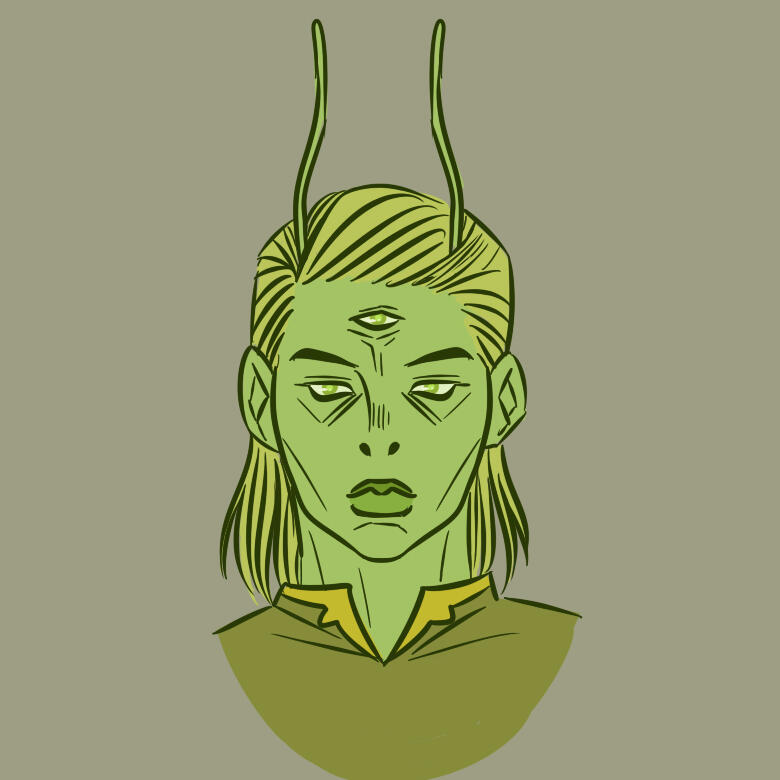
The advisor to Kurkrish Lenenia, and a member of the Kurkrish tribe. While he understands the strategic benefits of the Empire as a coalition, Selane resents the overarching power of the Emperor and seeks to restore the individual power of the southern tribe.
Subaba Anago
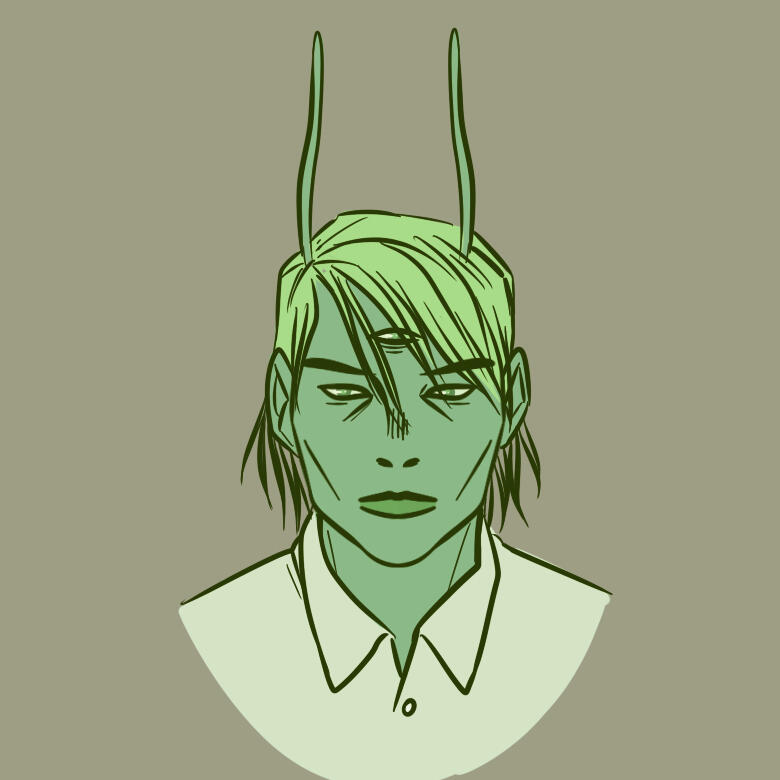
The de facto leader of the largest cell of the Diiri, a group of northern tribe members seeking to sabotage the Lakaa Empire's rise to power in the North. The Diiri are organized in individual cells, which function mostly independently from each other and know little of one another.
Santina's governments
Santina is made up of several countries with their own governments, most of which are allied under the Coalition of Nations, which is typically represented as a single entity in the Inter System Assembly (occasionally, one of the nations of the Coalition will represent itself independently on specific issues).The largest Santinan nations are:Vicaren – a representative democracy spanning most of the Vician and Tyaon regions of Santina. Vicaren is led by a single president. The nation is divided into thirty-one provinces. A number of representatives, between three and ten depending on the size of the province, are voted in to represent each province. These representatives are tasked with voting on the Vicarine president and on the passing of bills and legislation.Maronea – a direct democracy which governs the Basocene region as well as a small part of the Tyaon region. The Maronese people are led by three hundred senators, elected through popular vote. The Maronese Senate itself elects four figureheads, who represent the Senate and Maronea, however these figureheads do not have any more official political power than other senators and are bound to faithfully represent the interests of the Senate.Landor – a hereditary diarchy which governs the Landor region. Having historically been made up of two monarchies, the northern Kingdom of Korne and the southern Czardom of Inula, Landor has been unified for two centuries as a single nation, but is still controlled by the ruling lines of Inula and Korne. Landor continues to have two capitals, and the Inulan and Kornese rulers still divide their authority along the same lines. However, Landor is considered to be a single nation, in part thanks to intermarriage between the Inula and Korne lines, and Landoran citizens may freely move across the Landoran territory. Landor has adopted a single set of core laws, and a single currency. Taxes across the entire Landoran territory are divided between the two rulers, unifying the monarchies economically.Frinesi – an oligarchy which governs the Frinese Islands. Frinesi is not a part of the Coalition of Nations. Frinesi is governed by the members of a few noble families, which control a considerable amount of the Frinese wealth and resources.
Santinan Geography
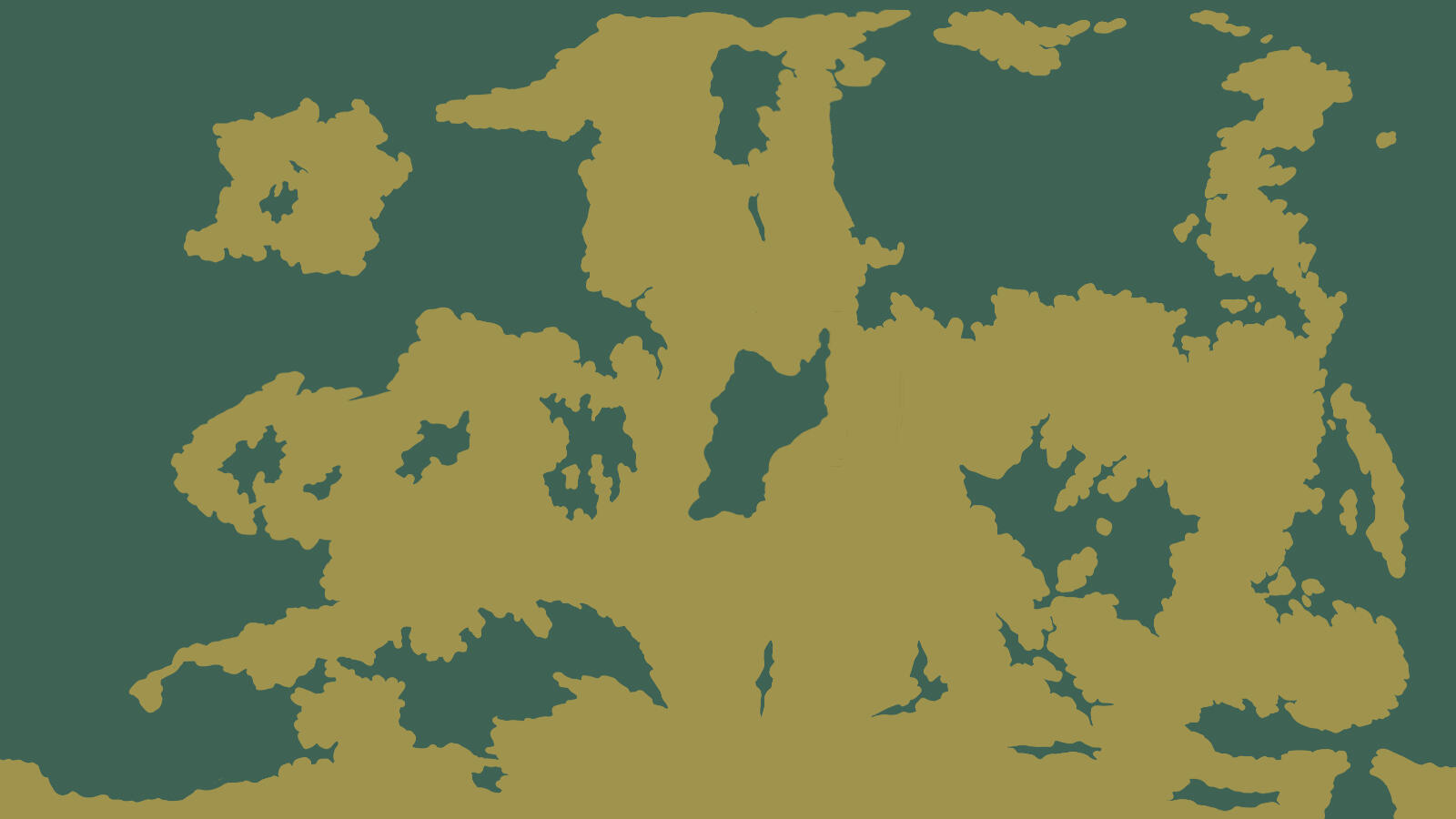
Map of Santina
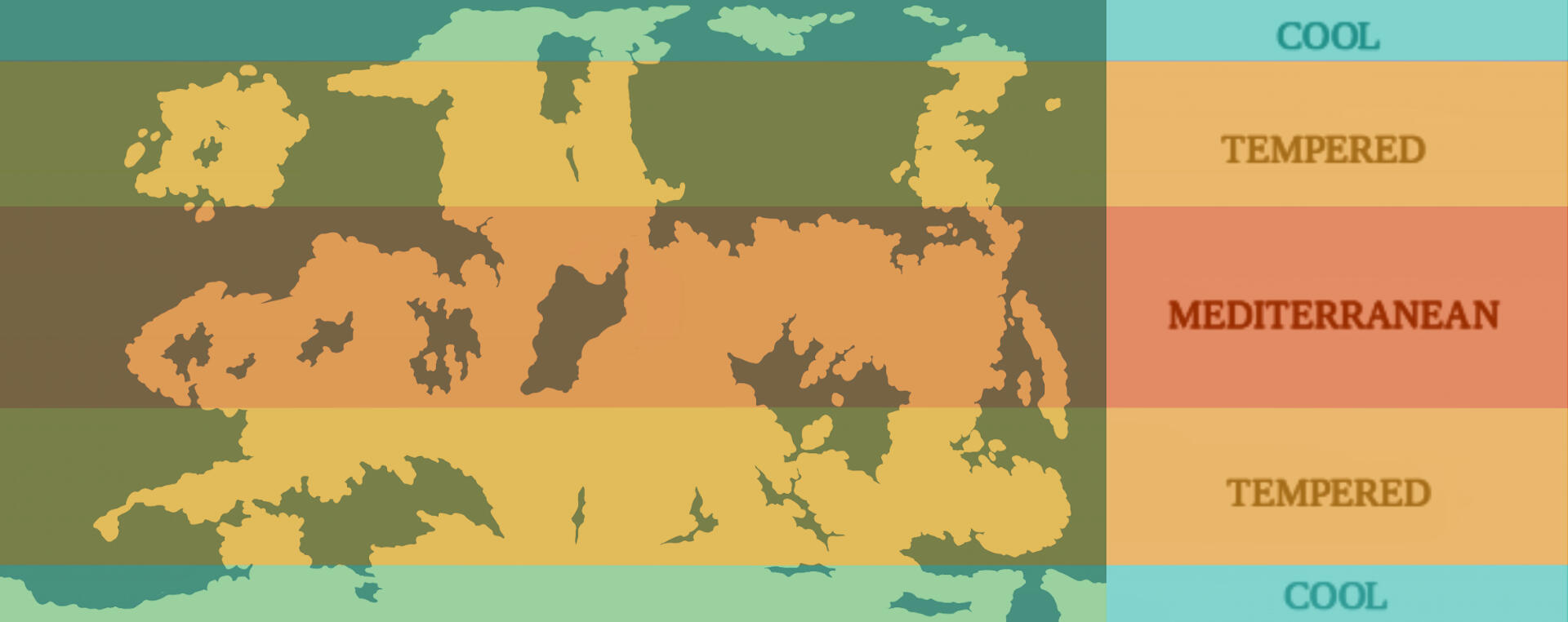
Santinan climates
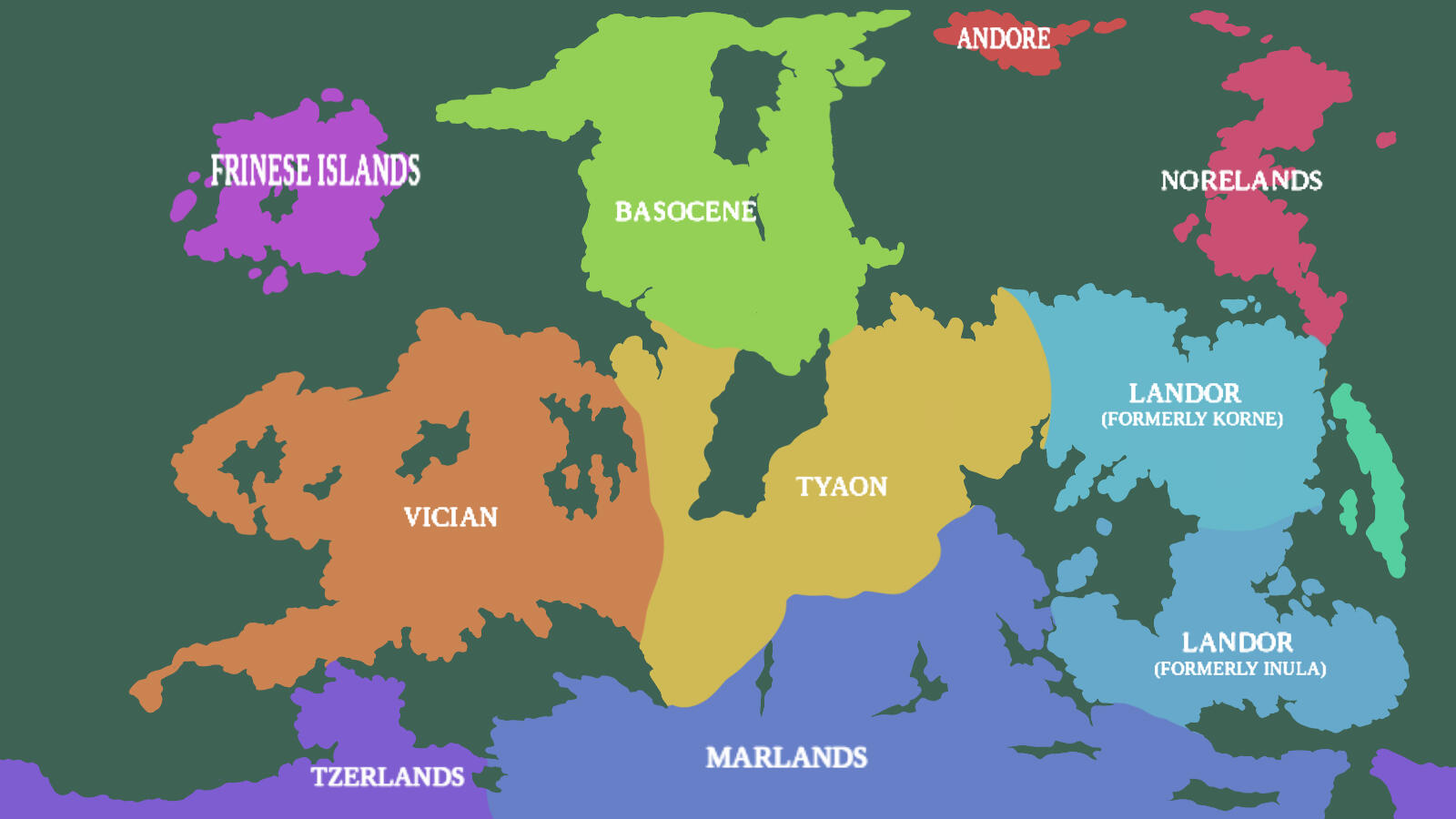
Santinan regions
Santinan cultures
Frinese Culture
Nobility
The Frinese Noble Houses are old, powerful families which govern Frinesi. They hold many noble titles which serve to legitimize their power; however, the main hold of their political power is their immense wealth, which they continue to grow with each generation.
While many dream of it, it is nigh-impossible for a commoner to become a noble - the Noble Houses keep to themselves, marrying between the families and keeping their power close at hand. It is, however, not impossible for a non-noble to marry into or be adopted into a Noble House, and it has been known to happen very rarely, fueling this dream for the general population.
Gender
The Frinese are the only Santinan population to use a three-gender system. The three genders are the timfrit (singular: imfri), the tanvit (anvi) and the tumvit (umvi).
The timfrit are associated with wisdom, integrity, creativity, and artistic talent. They are considered fit scholars, artists and politicians.
The tanvit are associated with nurturing, calm, and artisanal labor. They are considered best fit for child-rearing, gardening, farming, and metal and wood-working, all of which are considered nurturing activities.
The tumvit are associated with power, strength and decidedness, as well as protection and providing. They are usually considered best fit for positions of authority and strength, for war or policing, and for manual labor.
Frinesi functions on a duogamous nature, in relationships called "triads": people are expected to find one partner of each other gender - it is generally assumed that all three genders balance each other out and that such a balance is necessary for a healthy household. It is considered taboo and abnormal for a person to be involved with only one other (without seeking a third), or for their triad to include two or more people of the same gender.
The aforementioned gender roles are rather strict in Frinesi, and straying from them is heavily discouraged. However, because the three genders are not linked to sexual dimorphism, but function rather like castes, it is much easier to transition from one gender to another, and while this practice is taboo it is relatively common.
The Arts
Frinese culture heavily centers the arts as well as scholarly pursuits and the search for wisdom and beauty. Whether this is because of the place of the timfrit as heads of their households or the other way around is historically uncertain.
Frinese culture favors forms of art considered more 'natural', or 'of the Earth', over those considered unnatural or artificial; as such, technologically-aided art of any kind (photography, film, digital visual art, computerized music...) is regarded as low-brow and populist, while the favored arts are sculpting and pottery, painting, singing and playing instruments, and theater.
While an interest in art or some artistic pursuits are valued in all individuals, only the timfrit are considered fit to pursue a career in the arts. For those career artists, the epitome of success is patronage by a noble house. Some houses will even have artists residing with them and treated as a honorary noble, which is perhaps the most accessible way for a commoner to reach such status.
Operas
Operas are perhaps the cultural and artistic center of every Frinese city. Public operas are owned by noble families and operated by opera conductors appointed by them. They serve as operas, concert halls, and may sometimes be used for conferences or other large meetings - but they are most known and frequented as theatres. Public operas are typically very large, round buildings, which are very ornate and are used to display the wealth of their owners.Any large city will also have one or a few private operas - they are also owned by noble or wealthy families, and are very selective, operating on an invitation-only basis. These private operas are where the wealthy and powerful socialize and entertain themselves. They only employ popular and talented actors, and are known to put on exclusive plays, which the general public may never see. These plays are often longer than those put on in public operas, and may even require an entire day off during the workweek - a luxury the average citizen could not afford.Plays in public theatres are usually put on by travelling troupes - these are young people, usually timfrit, who are travelling in pursuit of knowledge and culture, and travel in groups, learning plays and playing them in operas to earn money. It is rare to see older actors in those troupes - if one wishes to remain an actor well into adulthood, they will usually have to settle down in one city, and will then seek to be employed in its private operas.
Leonel Serto

The current Vicarine president. Known for a primary focus on the economy and being 'hard on crime', though often criticized for a lack of focus on social issues.
Mesina Karihi

The best known of the Maronese figureheads. Videos of her speeches are shared all over the networks, and she is known for her humor and eloquency. She is fairly social justice oriented.
Asili s Abka

The current Inula Landoran ruler. Not so much is known of him as a person, on account of him being very private: most of his functions have been delegated to subordinates and he makes only very sparse appearances on important occasions.
Izmek Badir

The current Korne Landoran ruler. In complete contrast with S Abka, Badir is known for his extravagant parties and for being constantly in the public eye - to the point of being more like a celebrity than a ruler. He still delegates most of his workload.
Sul’ka ab Senteneo

A member of the Senteneo family, one of the richest Frinese families. Sul'ka is young, having recently inherited xis parent's title as head of the family, and power-hungry. Xe is little known to the public as of yet, but determined to make an impression.
Luciandra Listima

A weatlhy Vicarine business owner. She and her companies have much sway in Vicarine politics, and a near-monopoly on the oceanic travel market, a powerful market to control considering Vicarine geography.
Areedan Geography
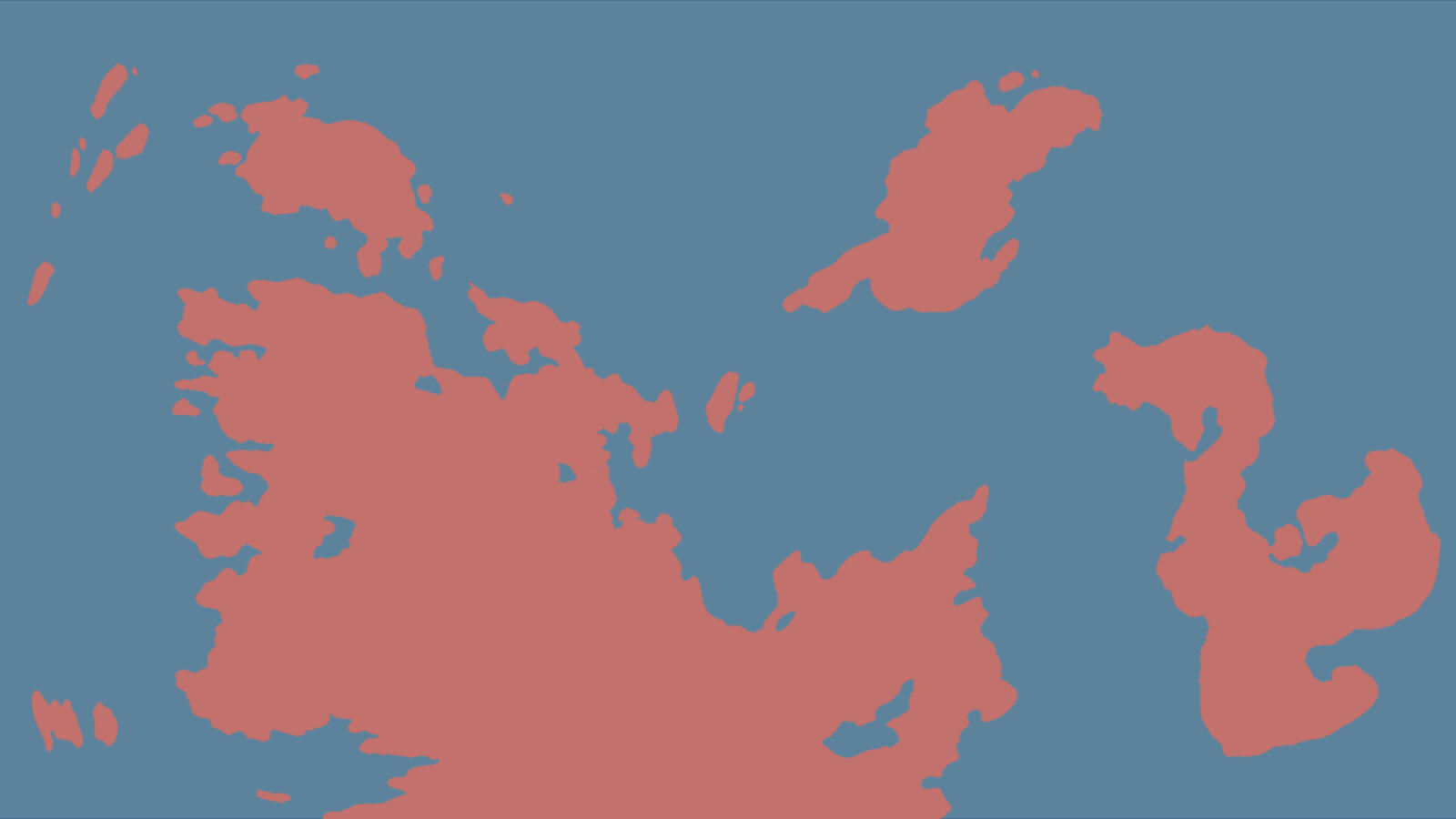
Map of Areeda
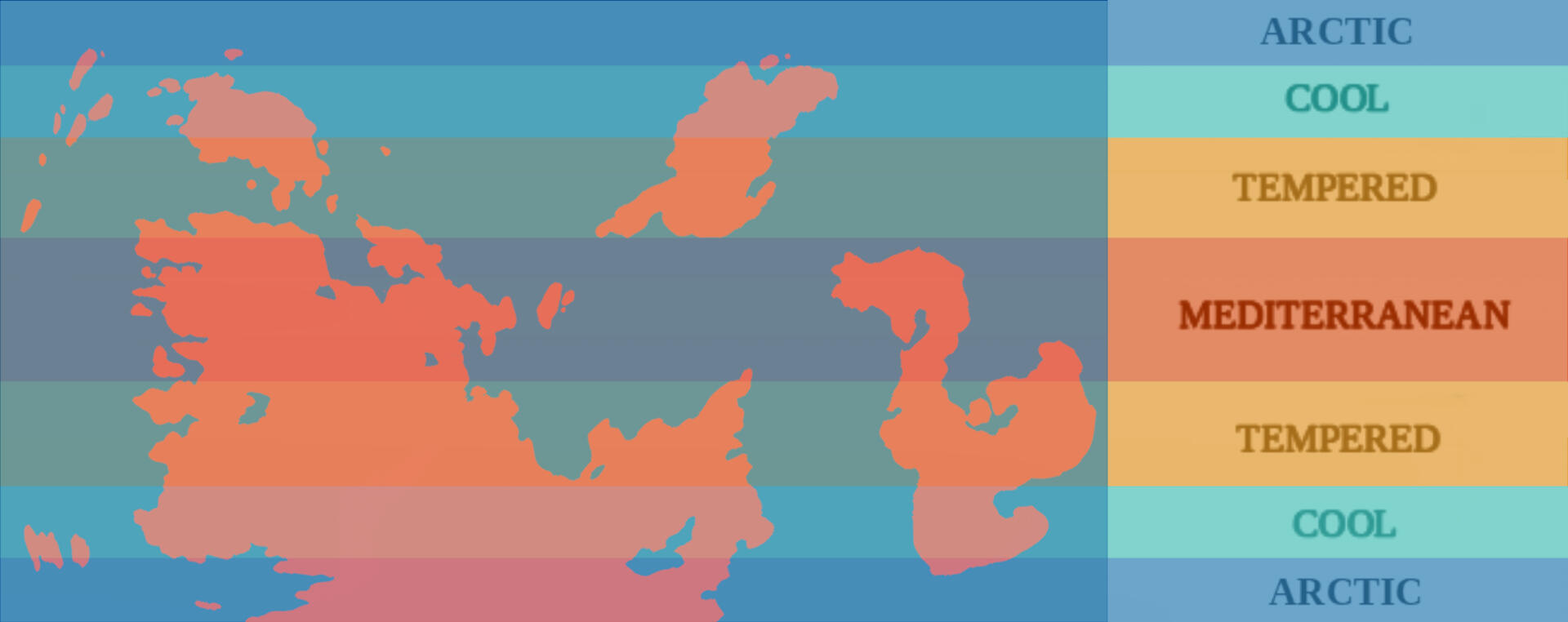
Areedan climates
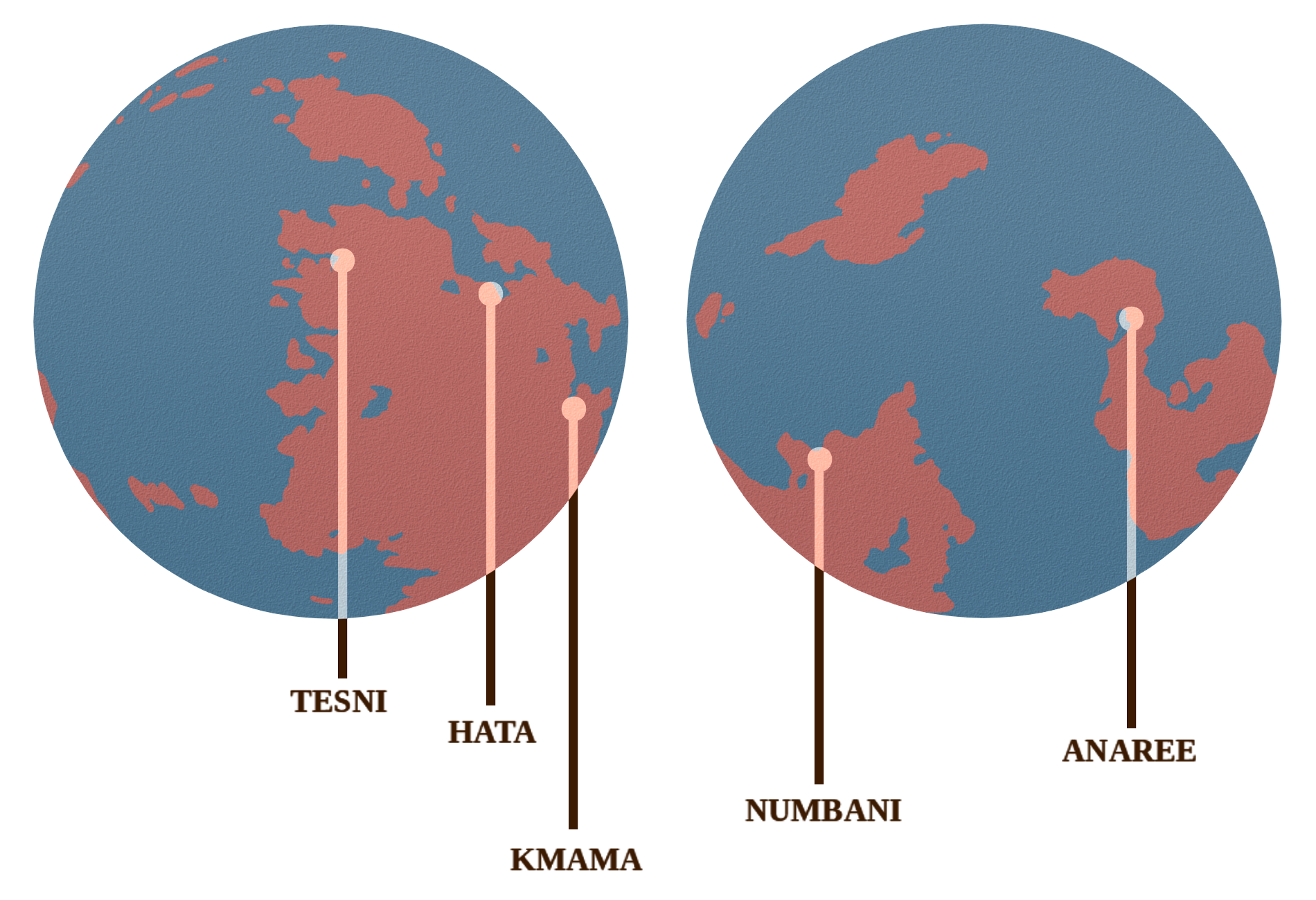
Santinan cities
Tesni - Areedan capital, contains the royal court
Hata - Economical capital
Kmama - Notable city
Numbani - Notable city
Anaree - Notable city